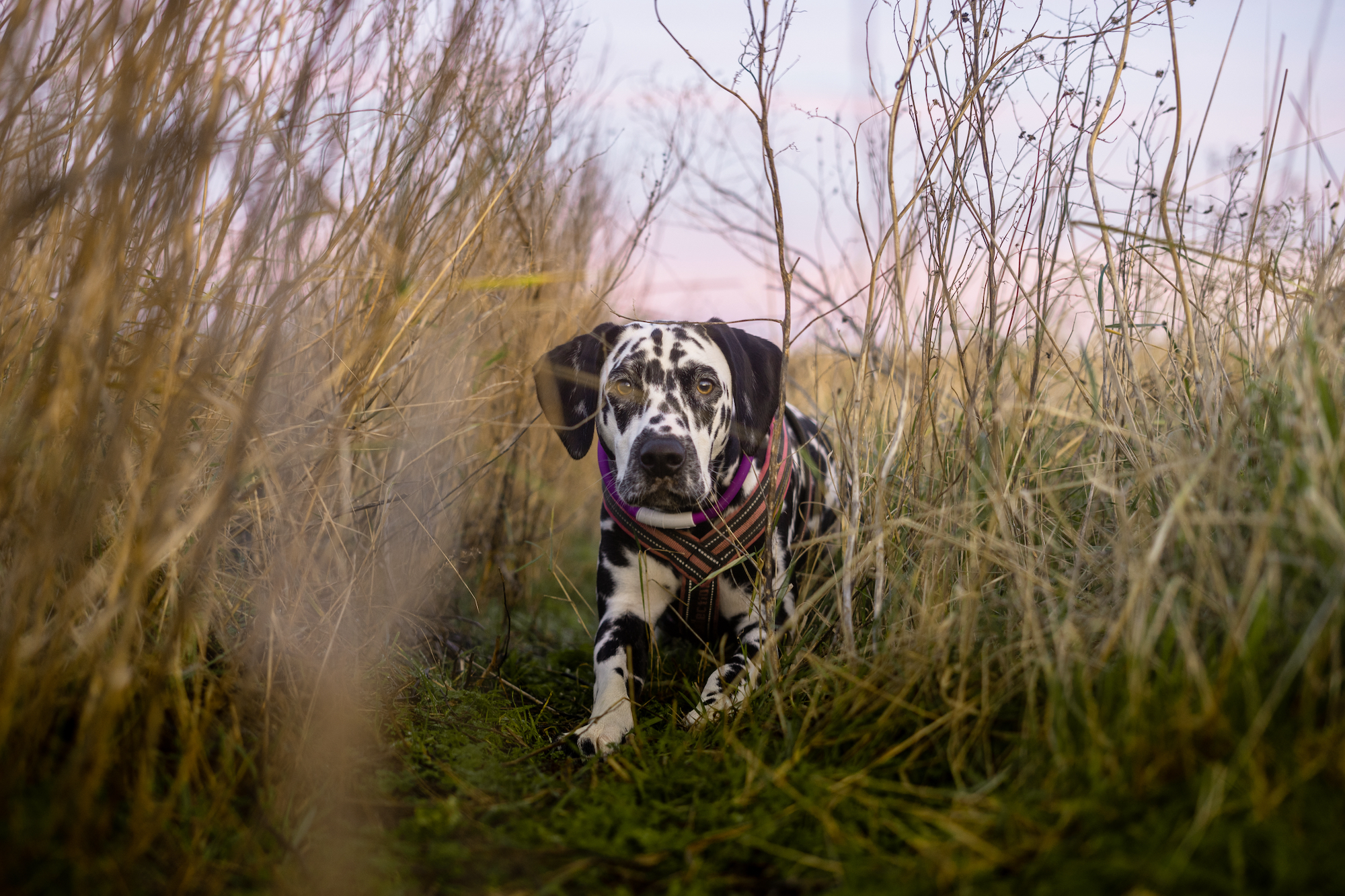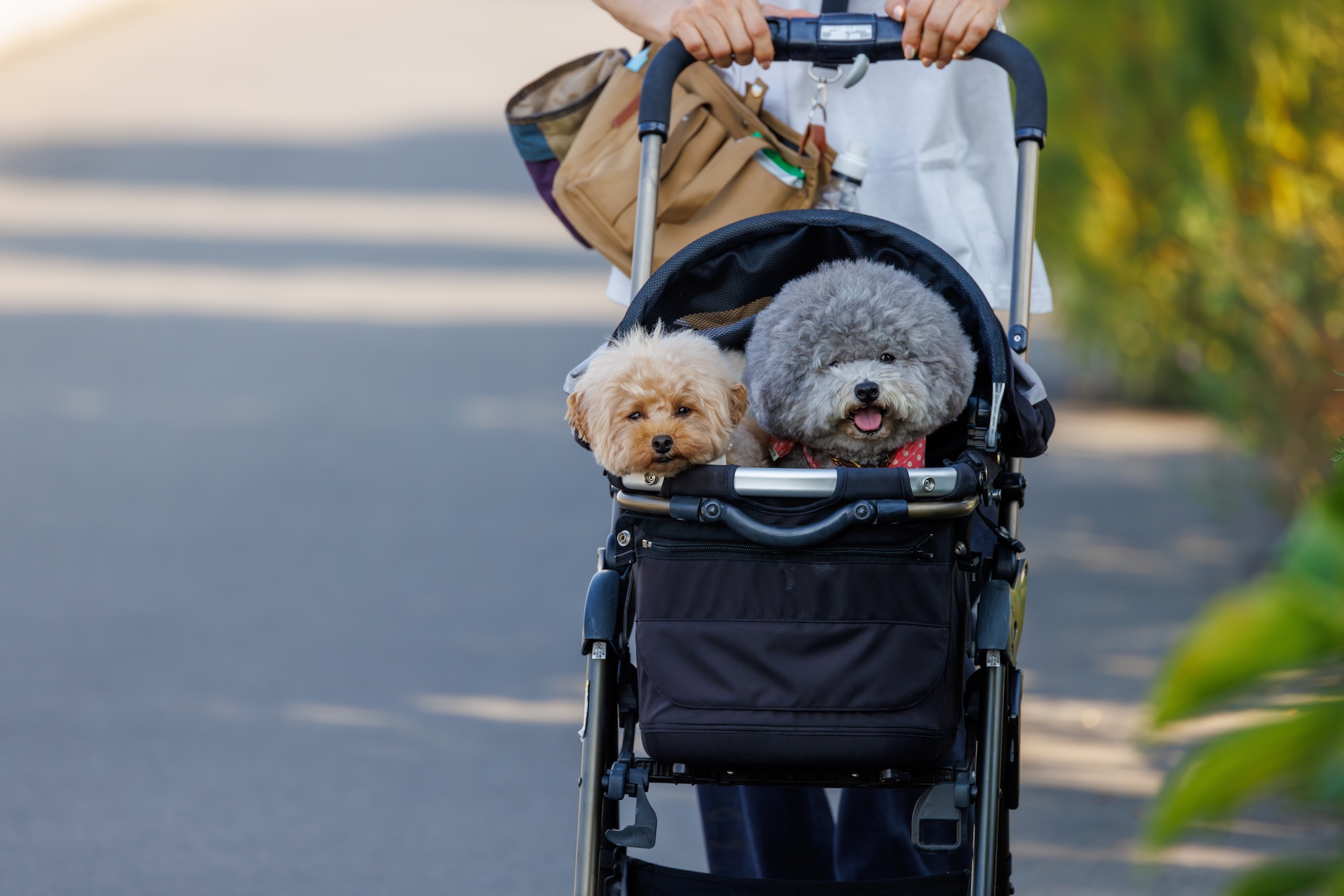Dogs’ fear of stimuli like skateboards, thunder, and mail carriers is well known, and often fodder for jokes. But for the dogs and their humans, canine fear can cause real problems. Research has found that fear is common in dogs: a Finnish study of 13,700 dogs found that 29% were fearful, with other dogs, strangers, and novel situations being the most common triggers. An even higher percentage of dogs were sensitive to loud noises.
When dogs are afraid, their “fight or flight” response can be activated, leading to behavior that could endanger them, other pets, or people. Plus, being afraid simply feels bad for the dog. As such, it’s important to find ways to alleviate dogs’ fear. This takes considerable time and effort, but it can be done.
Signs that a dog is afraid
The earlier you recognize signs of a dog’s fear, the earlier you can intervene to help them feel better and avoid consequences for both of you. Dogs who are afraid may show signs like tucking their tails, “whale eye” (wide eyes with the whites visible), shaking, yawning, ears pulled back, freezing, or hiding. Dogs who are afraid may also urinate or defecate, or stick close to a familiar human for comfort. Of course, these behaviors may also happen at other times, so you’ll need to take context into account.
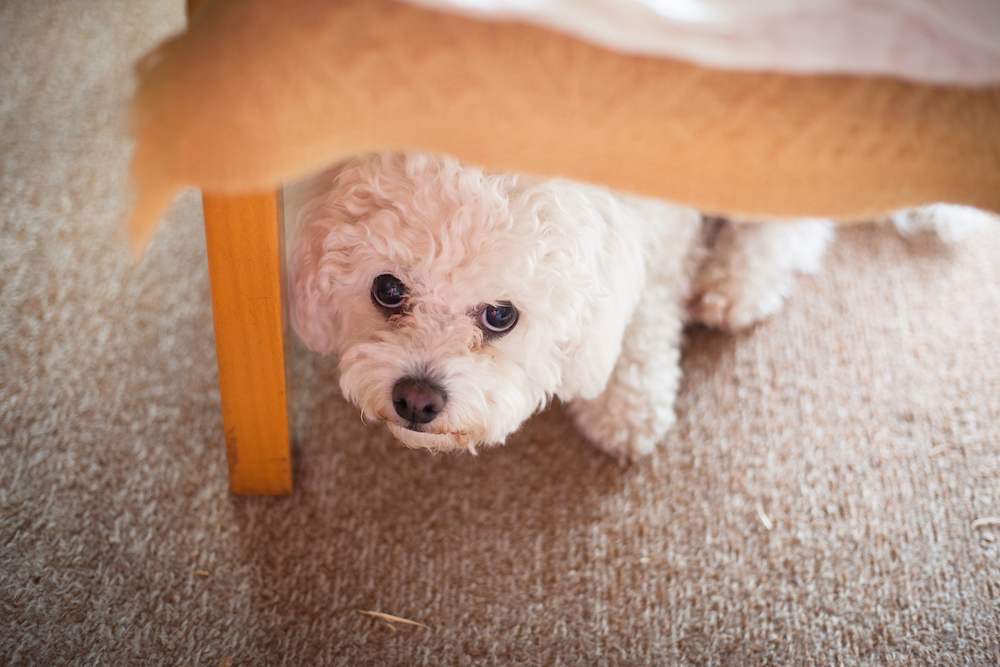
How to avoid a dog’s fear triggers
Nearly every human and animal is afraid sometimes. If we weren’t, we could pay the price for our fearlessness—some things are dangerous and worth being afraid of. We don’t suggest strolling across the middle of a highway. But fear becomes a problem when it interferes with our daily functioning and happiness, and the same goes for dogs. So if your dog is afraid of something that’s easy enough to keep away from them, one fix is to prevent them from encountering it.
“I don’t walk any dogs, really, past active construction sites if I can avoid it,” says Denise Herman, founder and head trainer at Empire of the Dog in New York City. “We run into active construction sites,” she says, “and there are dumpsters, and they’re throwing stuff into the dumpster. All it takes for some dogs is one or two times for them to get super startled by something on the street for them to say: ‘I don’t like that thing, I don’t like everything that I notice while that thing happens, I don’t want to go down that block, and I don’t like this time of day.’ Fear generalizes rapidly.” If it’s safe and convenient to cross the street and avoid what might frighten your dog, it’s fine to do so.
In fact, helping your dog avoid triggers when possible is useful even in situations when they’re getting over a fear—because a big part of the process is giving them experiences during which they encounter the source of their fear at a manageable intensity, and in a controlled environment.
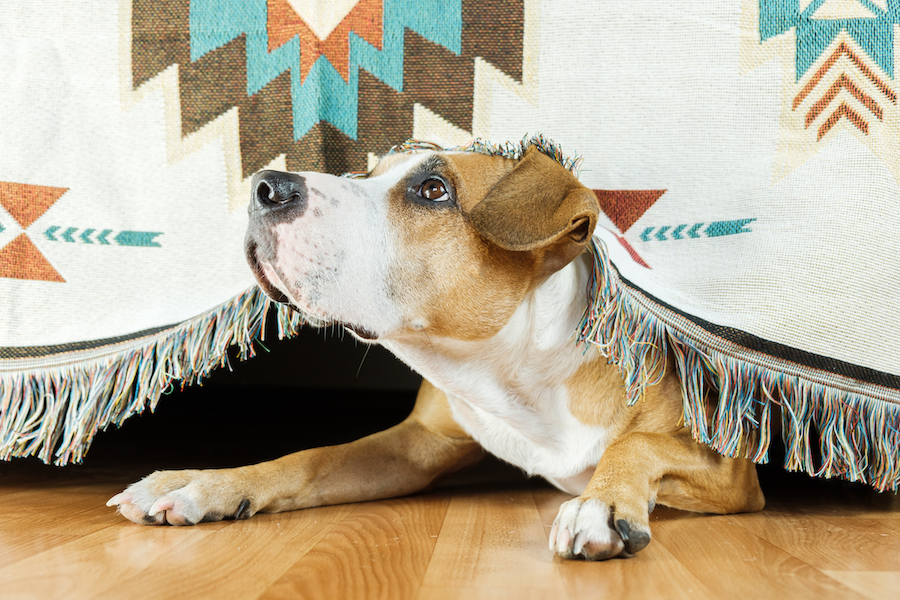
How to help a dog get over fears: desensitization and counterconditioning
The best tools available for helping a dog conquer a fear are desensitization and counterconditioning. You’ll often hear those two words together. In her book Wag: The Science of Making Your Dog Happy, Dr. Zazie Todd explains them this way:
“Desensitization means presenting the stimulus at a very low level that the dog is happy with, and gradually increasing it so the dog becomes used to it (the opposite of sensitization). In counter-conditioning, every single presentation of the stimulus is followed by something the dog likes (such as chicken or cheese) so the dog learns the stimulus predicts good stuff happening.”
These methods can apply to anything if you can control the level of the stimulus and the reward your dog receives in their presence. And they work; one study found counterconditioning more than 70% effective for dogs who feared fireworks.
But you have to do this right: a dog has to be calm in the presence of what was bothering them. If they’re showing signs that they’re afraid, or trying to escape, you need to turn it down. Don’t force them to stay and think you’re going to solve the problem by waiting it out or tossing treats their way. That is liable to make their fear worse.
You want to figure out what it is about the stimulus that’s scaring your dog and present it at a low enough level that the dog can coexist with it and not show any signs of stress.
“Whenever I’m thinking about a stimulus, like a person, that is scary to a dog,” says Maddie Messina, applied animal behaviorist and founder of Paws for Thought Dog Training in New York City, “I want to break that stimulus up into individual components. So maybe the sound of the stimulus, the visual component of the stimulus… for some dogs, maybe the olfactory component—the smell of the shampoo.”
When a dog can notice the stimulus, but not be afraid of it, they’re “under threshold.” It is in this state that they can learn to get over their fear.
Messina says that keeping the intensity of the stimulus low is key to helping a dog learn. “The main reason why you want to work with a dog being under threshold,” she says, “is that they’re still able to analyze stimuli that are coming into their brain and decide that they are safe or not safe appropriately—because once they’re over threshold, that thinking part of their brain is not really doing the majority of the work anymore. We need them to be cognizant of, ‘Oh, wait a minute, that thing that used to be scary to me—at this distance or intensity—it’s not that scary at this point.’”

Let your dog choose
“My golden rule,” Messina says, “is to never force a dog toward something that scares them or force them to remain in a space that is scary to them.”
If your dog is scared and wants to get away from something, let them do so as long as it’s safe. For desensitization and counterconditioning to work, they’ll have to be calm anyway—so protecting them from uncontrolled, intense versions of their fears serves the dual purposes of making them more comfortable and aiding their progress toward a less-fearful future.
Messina explains why it’s important to extract a dog from a situation when they’re showing that they’re scared. “As we practice behaviors, as both humans and dogs,” she says, “we solidify that kind of neural pathway—so we solidify that behavior in the future. If you continue to place your dog in situations that are overly stressful, and they as a result turn to barking or pacing to self-soothe, that choice to perform a behavior is going to be more likely to happen next time.”
Messina gives this example for a dog who’s afraid of other dogs on walks. “What is going to be inherently reinforcing for a dog,” she says, “is getting away from that scary thing. So we can practice a lot of management techniques on walks that help us to increase distance without having to instantly head home every time we see a dog. For example, we can do things like move in between cars and position our dog away from that upcoming dog.”
Doing this will benefit a dog on a few fronts: if they know they have a choice to leave a situation that scares them, they’ll be less likely to become upset or even aggressive—as they might if they’d felt cornered. And controlling their exposure to what they find scary will help with desensitization and counterconditioning—it’s better if a dog who’s afraid of other dogs can see them at a safe distance, when they can calmly receive treats, until they’re ready to take another step.
See if your dog can do some tricks
Counterconditioning works even if a dog can do nothing more than remain calm and take a treat—so you shouldn’t demand anything of them in exchange for a treat as you try to change their state of mind around something scary. However, their ability to perform certain basic tasks can indicate that they are in a good mental space to work through their issues.
“Is your dog able to perform basic skills in an environment that could be scary for them?”, Messina asks. “If they’re able to engage with you” by doing some tricks that they know, she says, “that’s not 100 percent perfect—but that’s sometimes a way we can assess if they’re still able to perceive stimuli without going into fight or flight.”
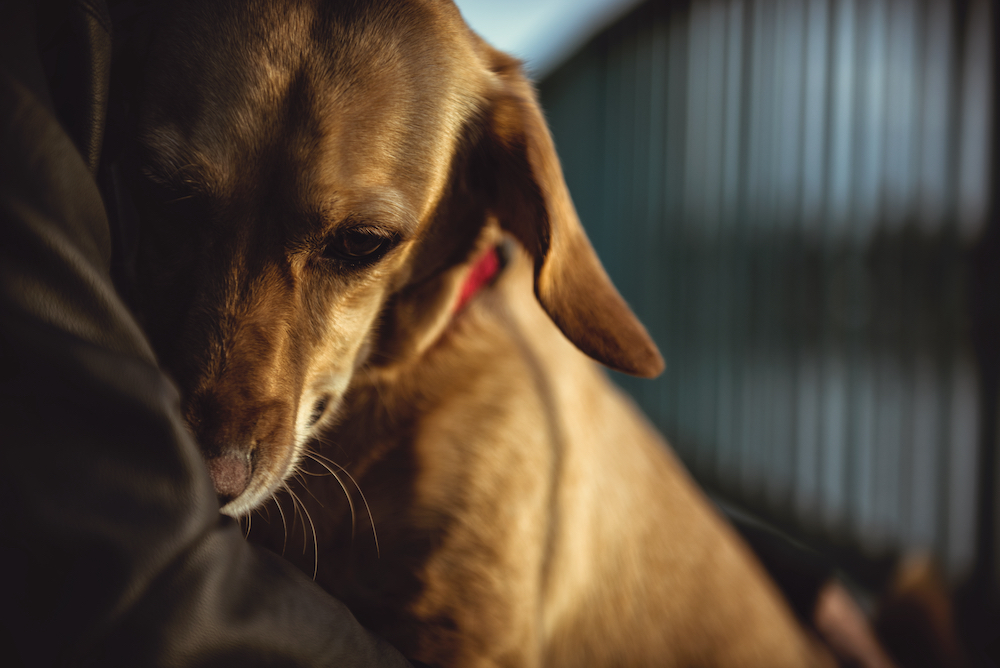
Go ahead—comfort your dog
It’s usually the case that you shouldn’t give a dog a treat when they’re doing something you don’t like. You don’t want, for example, to respond to a dog’s demand barking with a treat, lest you teach them that any time they want some extra food all they have to do is make a ruckus.
But, when it comes to counterconditioning, you don’t need to worry about that. If your dog comes to you for comfort when they’re scared, and they like affection, you can feel free to pet them and tell them they’ll be fine.
You can’t reinforce fear by comforting your dog, because fear is an emotion rather than a behavior. So if your dog seems to feel better when you pet them and talk nicely to them, do so.
“Comforting them is never going to make fear worse,” Herman says, “Unless you’re also doing something that is forcing them to be in the situation when you really should have left it.” She gives this example about a dog who’s afraid of children: “A lot of people hold their dog and try to comfort them,” she says, “and the baby toddles up, and they say: ‘look, it’s a safe baby.’ If your dog isn’t actively going up to the thing, the thing should not be coming at your dog. People will think ‘I comforted him, and then he got worse.’ He didn’t get worse because you were comforting him; he got worse because he kept being exposed to the stimuli above an amount that he could handle emotionally.”
While you should comfort a dog who asks for it, you’ll get better results if you incorporate desensitization and counterconditioning into the moment as well. “You’re going to get more traction bringing out heavier good artillery,” Herman says. “So that your dog isn’t on your lap, but they’re still, like, ‘Oh my God, the thing is so scary.’ So I can say ‘What thing? Look at this!’ And throw some treats, or get a favorite toy, or moderate the threshold that the scary thing is at… if it’s thunder, you wouldn’t sit by the window and comfort your dog. You wouldn’t keep the windows open. You would turn the TV on and retreat a little to an interior room so that they don’t have to experience it at a volume of 10.”
“If your child were struggling,” Messina says, “you would probably reach down and help them feel a little bit better, work through that moment—and it’s totally fine to do that with your dog as well.”
Be patient
You’re unlikely to get instant results, and shouldn’t believe anyone who tells you that they can guarantee them.
“We’re not usually talking about a matter of minutes or days,” Herman says of the timeline for overcoming a fear, “unless the dog is a super-young puppy under three months. Four months or older, you’re typically talking days to a month or more depending on how well you control the narrative.”
Messina is blunt about the usual pace of improvement. “The way that trainers like me apply counterconditioning and desensitization techniques,” she says, “is the most potentially excruciatingly boring thing to watch. Going from 0 to 60, and then trying to apply your training skills at 60, is not going to adequately resolve anything. We start at level 0 first to build the foundation of skills. and then we move up to 10, and then we move up to 20—thinking about how we can sequentially increase the difficulty.”
In other words, don’t expect to toss a handful of treats toward your dog and see them cured of their fears. It’s going to take time—you’re not trying to change only how they act, but also how they feel about something.
“If a dog is sensitive to any of the aspects of the stimulus,” Messina says, “and they are crossing over threshold—going into stiff body, unable to engage with me anymore, barking, lunging—then I have to work below that level and, as the dog gains comfort, move that level slowly up over time. So the reality is the dog sets the pace.”
On the bright side, Herman says that the longer you keep at desensitization and counterconditioning, the better your dog is likely to get. “It’s not like obedience training,” she says. “If you do everything right, [desensitization and counterconditioning] gets faster and better the longer you’re doing it—versus the way other training looks amazing when you first start, and then the gains that you make—like, ‘sit’ doesn’t get exponentially better the longer you do it. You see the first big gains in the first week or two, and you’re like, ‘My dog is amazing! He’s sitting all the time now.’ A year later, people aren’t like, ‘My dog is sitting better than he ever has…’ When you’re talking about emotional stuff, you’re more successful the longer you stick to it.”
Socialize puppies to make fears less likely
If you have a puppy who hasn’t developed fears, you can take steps to try to prevent them from arising in the first place via socialization. Research has found that dogs who are poorly socialized when they’re young can be more fearful.
Herman gives this example of how she helps puppies get used to balloons: “When I would do puppy class,” she says, “I would blow up a balloon. And when I take care of dogs, I play with them and get them used to balloons. But we under-inflate them, because you certainly don’t want to blow up a big balloon, and your dog gets comfortable with it, and it pops.” That’s one of the keys to this type of exposure—you want your dog’s early experiences with the stimulus to be positive so that they can build up a record of safe, happy memories around it.
Whatever your dog’s age, protecting them from trauma can also head off problems—see Herman’s point above about avoiding loud, chaotic construction sites where dogs might have bad experiences that spawn fears.
Having said that, don’t assume that if your dog becomes fearful it’s because you’ve done something wrong. Not only is life full of situations that can’t be fully controlled, but genetic factors influence dogs’ susceptibility to fear. Like humans, some dogs are born more likely to be nervous or scared.
Ask for help if you need it
“If you’re not seeing any progress in the right direction,” Messina says, “I would reach out to a professional.”
If you feel that you’re stuck—your dog is miserable, behaving in ways that are dangerous to themselves or others, or simply not improving—call in a qualified, responsible professional who can help you diagnose and address the problem. Their methods should be some version of what’s outlined above, and they shouldn’t promise instantaneous results, but it’s often useful to have an expert’s perspective and guidance.
You may also want to visit a veterinarian—dogs’ behavior can change because of pain or other physical problems that might turn up on an exam.
All in all, it’s worth making this effort, because dogs who spend much of their time afraid are suffering.
“Emotionally,” Herman says of dogs whose fears aren’t improving, “there’s a hole being dug. How deep do you want it to get before you start trying to dig yourself out of it?”
